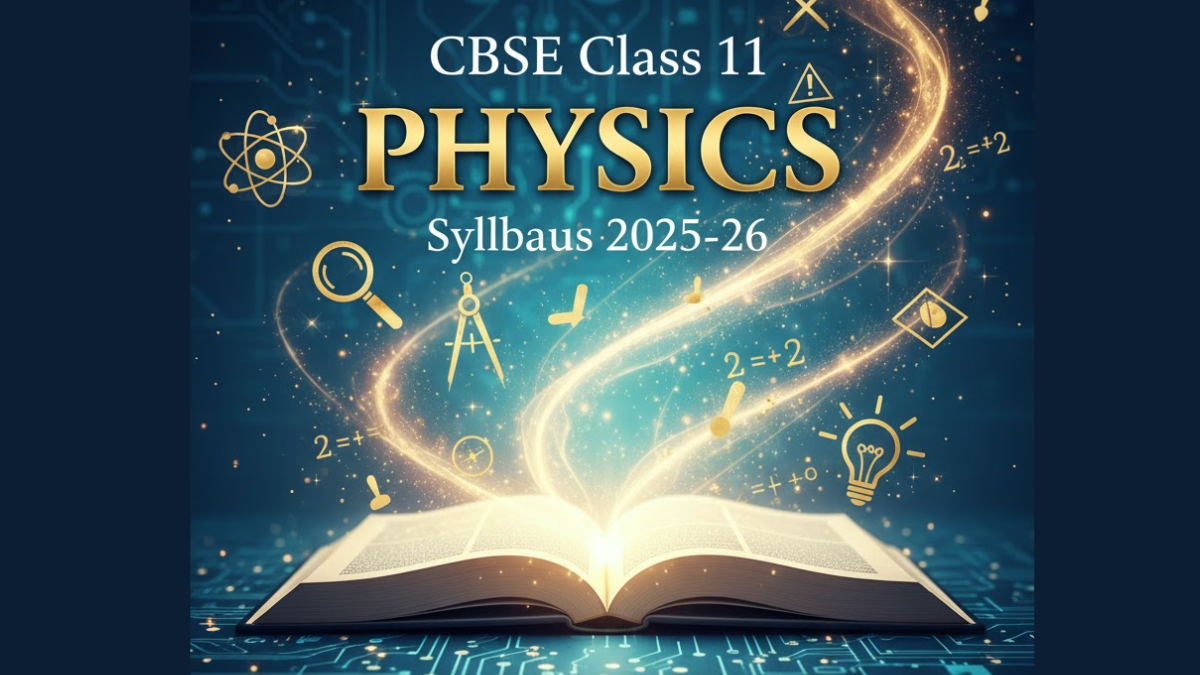CBSE Class 11 Physics Syllabus 2025-26 gives a solid basis in physics, which is required for grasping more complicated concepts in Class 12 and continuing future courses in science, engineering, and research. This page allows you to download the entire NCERT syllabus for class 11 Physics PDF 2026 and study all of the new chapters, subjects, and assessment systems. Our easy-to-read, detailed Class 11 Physics Syllabus Chapter-wise includes useful information on question paper design, evaluation methodologies, and more. The whole physics curriculum is divided into papers –
- Theory Paper – 70 marks
- Practical Paper – 30 marks
CBSE Class 11 Physics Syllabus 2025-26
The CBSE Class 11 Physics Syllabus 2025-26 is intended to teach students these essential principles and provide them with the tools necessary to understand physical phenomena and solve related problems. Download the syllabus of Physics Class 11th and begin arranging your study regimen. Here we provide a full overview of the CBSE Class 11 Physics Syllabus, including units, chapters within those units, total marks, internal assessments, and much more.
Marking Scheme of NCERT Class 11th Physics Curriculum
All unit-wise and chapter-wise NCERT Class 11 Physics Syllabus are tabulated below –
| Unit No. | Unit Name | Unit Chapters | Number of Periods | Total Marks |
| I | Physical World and Measurement | Units and Measurements | 8 |
23
|
|
II
|
Kinematics
|
Motion in a Straight Line |
24
|
|
| Motion in a Plane | ||||
| III | Laws of Motion | Laws of Motion | 14 | |
| IV | Work, Energy and Power | Work, Energy and Power | 14 |
17
|
| V | Motion of System of Particles and Rigid Body | System of Particles and Rotational Motion | 18 | |
| VI | Gravitation | Gravitation | 12 | |
|
VII
|
Properties of Bulk Matter
|
Mechanical Properties of Solids |
24
|
20
|
| Mechanical Properties of Fluids | ||||
| Thermal Properties of Matter | ||||
| VIII | Thermodynamics | Thermodynamics | 12 | |
| IX | Behavior of Perfect Gases and Kinetic Theory of Gases | Kinetic Theory | 8 | |
|
X
|
Oscillations and Waves
|
Oscillations |
26
|
10
|
| Waves | ||||
| Total | 160 | 70 | ||
| Practicals | 30 | |||
| TOTAL MARKS | 100 | |||
NCERT Class 11th Physics Syllabus 2026
Here is the NCERT Class 11 Physics Syllabus 2026 in detail –
| Unit No. | Unit Name | Unit Chapters | Topics Covered |
| I | Physical World and Measurement | Units and Measurements |
Need for measurement Units of measurement
Systems of units SI units Fundamental and derived units Significant figures. Dimensions of physical quantities Dimensional analysis and its applications |
|
II
|
Kinematics
|
Motion in a Straight Line |
Frame of reference, Motion in a straight line
Elementary concepts of differentiation and integration for describing motion Uniform and nonuniform motion Instantaneous velocity Uniformly accelerated motion Velocity – time and position-time graphs Relations for uniformly accelerated motion (graphical treatment) |
| Motion in a Plane |
Scalar and vector quantities
Position and displacement vectors General vectors Equality of vectors Scalar and Vector product of vectors Motion in a plane Cases of uniform velocity |
||
| III | Laws of Motion | Laws of Motion |
Intuitive concept of force
Inertia Newton’s first law of motion Newton’s second law of motion Newton’s third law of motion Law of conservation of linear momentum and its applications Static and kinetic friction Dynamics of uniform circular motion |
| IV | Work, Energy and Power | Work, Energy and Power |
Work done by a constant force and a variable force
kinetic energy Work-energy theorem Notion of potential energy potential energy of a spring Conservative forces Non-conservative forces Motion in a vertical circle Elastic and inelastic |
| V | Motion of System of Particles and Rigid Body | System of Particles and Rotational Motion |
Centre of mass of a two-particle system
Momentum conservation Centre of mass motion Centre of mass of a rigid body Equilibrium of rigid bodies Moment of inertia, Values of moments of inertia for simple geometrical objects (no derivation) |
| VI | Gravitation | Gravitation |
Kepler’s laws of planetary motion
Acceleration due to gravity and its variation with altitude and depth Gravitational potential energy and gravitational potential Orbital velocity of a satellite |
|
VII
|
Properties of Bulk Matter
|
Mechanical Properties of Solids |
Elasticity
Stress-strain relationship Hooke’s lawYoung’s Bulk modulus Poisson’s ratio Elastic Energy |
| Mechanical Properties of Fluids |
Pressure due to a fluid column
Pascal’s law and its applications Viscosity Stokes’ law Surface energy and surface tension Application of surface tension ideas to drops Bubbles and capillary rise |
||
| Thermal Properties of Matter |
Heat
Temperature Thermal Expansion Thermal expansion of solids Liquids and gasses Specific heat capacity Change of state-latent heat capacity |
||
| VIII | Thermodynamics | Thermodynamics |
Thermal equilibrium and definition of temperature
Zeroth law of thermodynamics Heat Work and internal energy First law of thermodynamics |
| IX | Behavior of Perfect Gases and Kinetic Theory of Gases | Kinetic Theory |
Equation of state of a perfect gas, work done in compressing a gas
Kinetic theory of gasses Kinetic interpretation of temperature Degrees of freedom Concept of mean free path Avogadro’s number |
|
X
|
Oscillations and Waves
|
Oscillations |
Periodic motion – time period
Displacement as a function of time Periodic functions and their applications Simple harmonic motion (S.H.M) Phase Energy in S.H.M Kinetic and potential energies |
| Waves |
Wave motion
Transverse and longitudinal waves Speed of traveling wave Displacement relation for a progressive wave Reflection of waves Beats Fundamental mode and harmonics Principle of superposition of waves |
Internal Assessment of Class 11 Physics
| Topic | Marks | |
| Two experiments one from each section | 7+7= 14 | |
|
Practical record (experiment and activities)
|
5
|
|
| One Investigatory Project of any 3 | ||
| Viva on experiments, activities and project | 5 | |
| Total | 30 |
CBSE Class 11 Physics Syllabus 2026 PDF Download
The CBSE Class 11 Physics syllabus PDF is an essential component of the science stream for students in their first year of higher secondary education. Download the PDF of the CBSE Board class 11 Physics syllabus with internal assessment.
| Subject | PDF Link |
| Physics | Click Here |
Importance of Class 11 Physics Syllabus 2026
Every student who wishes to excel in the upcoming academic year must get the most recent NCERT syllabus for class 11 Physics PDF 2025-26. Here’s why this is very important:
- Get a full chapter-by-chapter overview of the entire class 11 Physics syllabus for 2026, including all new topics and assessment methods.
- The full NCERT syllabus for class 11 Physics will help you plan and collect all of the books, notes, and resources you’ll need for each course.
- Organize your study schedule wisely using the official NCERT syllabus for class 11 Physics PDF, ensuring that you complete every crucial chapter on time.
- Get the first word on any additions or modifications to the chapters of the class 11 Physics curriculum so you don’t miss any new information.
- Concentrate your attention on high-weightage portions and significant units of the class 11 Physics curriculum.











 AILET 2026 AIR 1: Check Full Toppers Lis...
AILET 2026 AIR 1: Check Full Toppers Lis...
 AILET Result 2026 OUT, How to Download S...
AILET Result 2026 OUT, How to Download S...
 CUET PG Crash Course 2026: Subject-Wise ...
CUET PG Crash Course 2026: Subject-Wise ...














